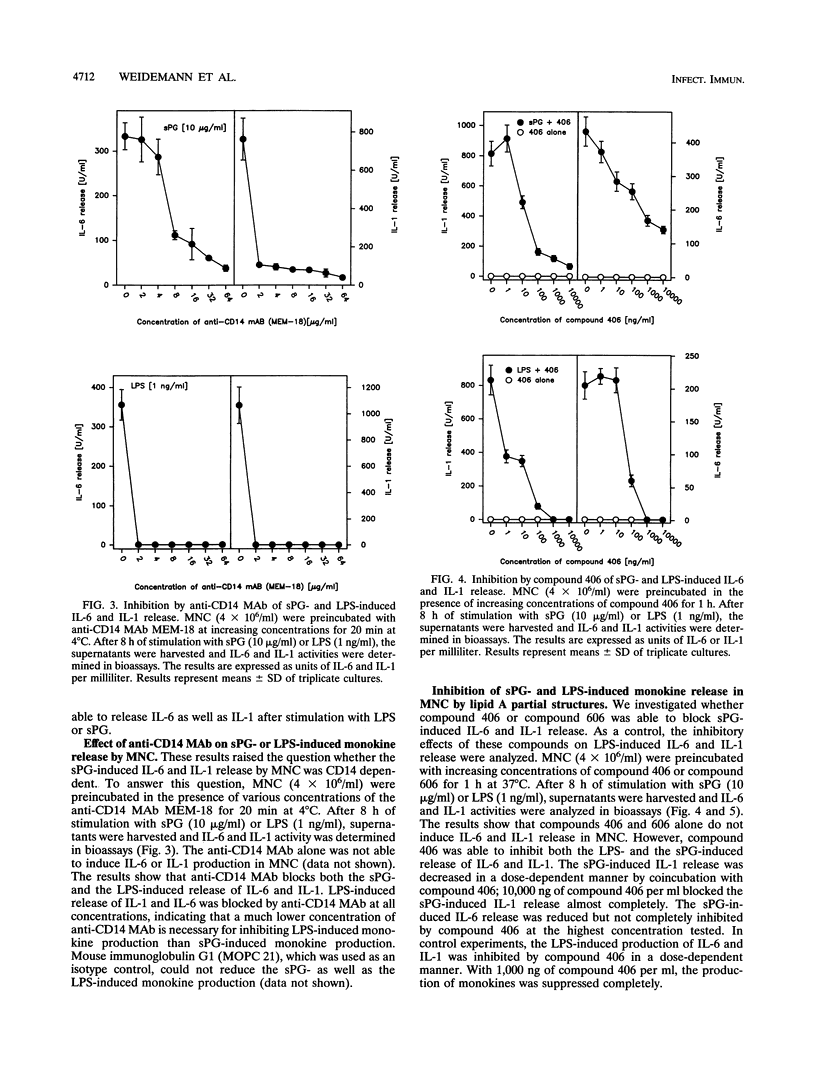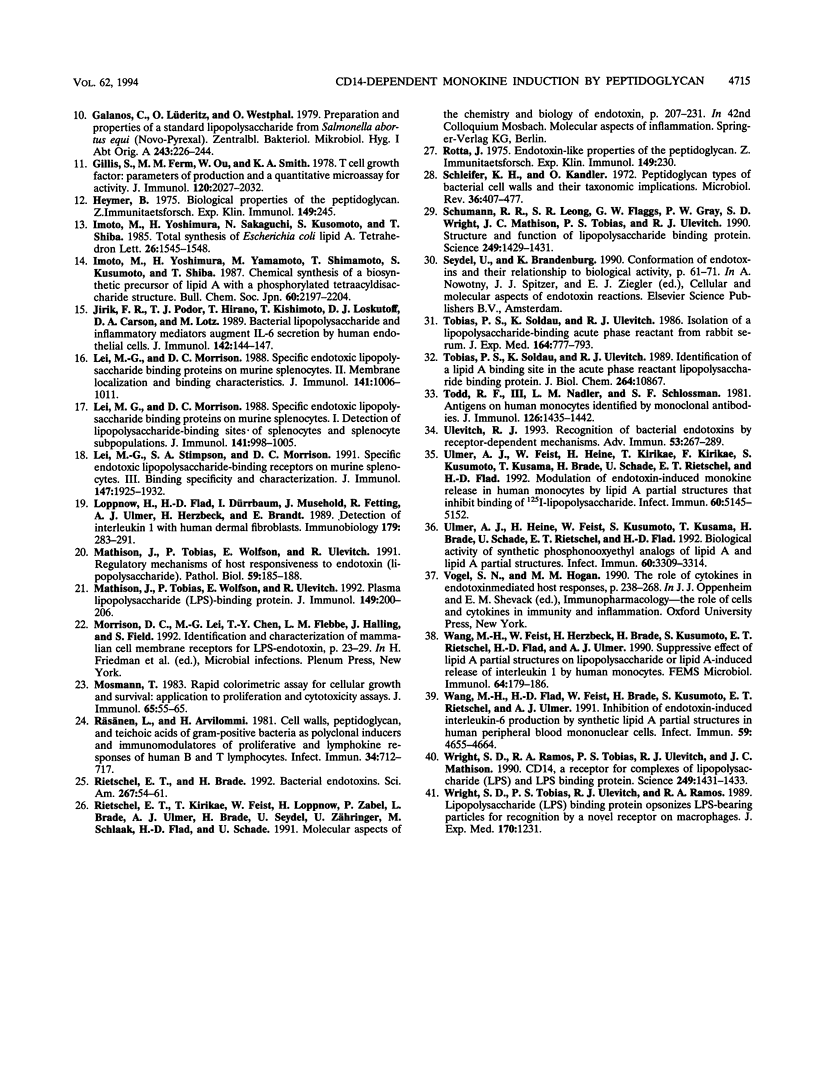Abstract
We have investigated the interaction of soluble peptidoglycan (sPG), in comparison with lipopolysaccharide (LPS), with human mononuclear cells (MNC) by determining the capacity of sPG to induce interleukin-6 (IL-6) and IL-1 release. In addition, we investigated the modulation of their interaction by anti-CD14 monoclonal antibody and by partial structures of LPS. We found that sPG, like LPS, was able to induce IL-6 and IL-1 production by MNC. However, dose-response experiments revealed that at least 3,000 ng of sPG per ml was necessary for induction, whereas the optimal LPS concentration was 1 ng/ml. Anti-CD14 monoclonal antibody reduced sPG- and LPS-induced IL-6 and IL-1 production. Moreover, partial structures of LPS were able to reduce monokine production induced by sPG and LPS. We conclude that sPG constitutes, like LPS, an inflammatory cytokine inducer and that CD14 is involved in the activation of human monocytes not only by LPS but also by sPG.
Full text
PDF






Selected References
These references are in PubMed. This may not be the complete list of references from this article.
- Bazil V., Horejsí V., Baudys M., Kristofová H., Strominger J. L., Kostka W., Hilgert I. Biochemical characterization of a soluble form of the 53-kDa monocyte surface antigen. Eur J Immunol. 1986 Dec;16(12):1583–1589. doi: 10.1002/eji.1830161218. [DOI] [PubMed] [Google Scholar]
- Böyum A. Isolation of mononuclear cells and granulocytes from human blood. Isolation of monuclear cells by one centrifugation, and of granulocytes by combining centrifugation and sedimentation at 1 g. Scand J Clin Lab Invest Suppl. 1968;97:77–89. [PubMed] [Google Scholar]
- Dinarello C. A. Biology of interleukin 1. FASEB J. 1988 Feb;2(2):108–115. [PubMed] [Google Scholar]
- Dziarski R. Demonstration of peptidoglycan-binding sites on lymphocytes and macrophages by photoaffinity cross-linking. J Biol Chem. 1991 Mar 15;266(8):4713–4718. [PubMed] [Google Scholar]
- Dziarski R., Dziarski A. Mitogenic activity of staphylococcal peptidoglycan. Infect Immun. 1979 Mar;23(3):706–710. doi: 10.1128/iai.23.3.706-710.1979. [DOI] [PMC free article] [PubMed] [Google Scholar]
- Dziarski R. Peptidoglycan and lipopolysaccharide bind to the same binding site on lymphocytes. J Biol Chem. 1991 Mar 15;266(8):4719–4725. [PubMed] [Google Scholar]
- Dziarski R. Polyclonal activation of immunoglobulin secretion in B lymphocytes induced by staphylococcal peptidoglycan. J Immunol. 1980 Dec;125(6):2478–2483. [PubMed] [Google Scholar]
- Feist W., Ulmer A. J., Wang M. H., Musehold J., Schlüter C., Gerdes J., Herzbeck H., Brade H., Kusumoto S., Diamantstein T. Modulation of lipopolysaccharide-induced production of tumor necrosis factor, interleukin 1, and interleukin 6 by synthetic precursor Ia of lipid A. FEMS Microbiol Immunol. 1992 Jan;4(2):73–89. doi: 10.1111/j.1574-6968.1992.tb04973.x. [DOI] [PubMed] [Google Scholar]
- Flad H. D., Loppnow H., Rietschel E. T., Ulmer A. J. Agonists and antagonists for lipopolysaccharide-induced cytokines. Immunobiology. 1993 Apr;187(3-5):303–316. doi: 10.1016/S0171-2985(11)80346-3. [DOI] [PubMed] [Google Scholar]
- Galanos C., Lüderitz O., Westphal O. Preparation and properties of a standardized lipopolysaccharide from salmonella abortus equi (Novo-Pyrexal). Zentralbl Bakteriol Orig A. 1979 Apr;243(2-3):226–244. [PubMed] [Google Scholar]
- Gillis S., Ferm M. M., Ou W., Smith K. A. T cell growth factor: parameters of production and a quantitative microassay for activity. J Immunol. 1978 Jun;120(6):2027–2032. [PubMed] [Google Scholar]
- Heymer B. Biological properties of the peptidoglycan. Z Immunitatsforsch Exp Klin Immunol. 1975 Jul;149(2-4):245–257. [PubMed] [Google Scholar]
- Jirik F. R., Podor T. J., Hirano T., Kishimoto T., Loskutoff D. J., Carson D. A., Lotz M. Bacterial lipopolysaccharide and inflammatory mediators augment IL-6 secretion by human endothelial cells. J Immunol. 1989 Jan 1;142(1):144–147. [PubMed] [Google Scholar]
- Lei M. G., Morrison D. C. Specific endotoxic lipopolysaccharide-binding proteins on murine splenocytes. I. Detection of lipopolysaccharide-binding sites on splenocytes and splenocyte subpopulations. J Immunol. 1988 Aug 1;141(3):996–1005. [PubMed] [Google Scholar]
- Lei M. G., Morrison D. C. Specific endotoxic lipopolysaccharide-binding proteins on murine splenocytes. II. Membrane localization and binding characteristics. J Immunol. 1988 Aug 1;141(3):1006–1011. [PubMed] [Google Scholar]
- Lei M. G., Stimpson S. A., Morrison D. C. Specific endotoxic lipopolysaccharide-binding receptors on murine splenocytes. III. Binding specificity and characterization. J Immunol. 1991 Sep 15;147(6):1925–1932. [PubMed] [Google Scholar]
- Loppnow H., Flad H. D., Dürrbaum I., Musehold J., Fetting R., Ulmer A. J., Herzbeck H., Brandt E. Detection of interleukin 1 with human dermal fibroblasts. Immunobiology. 1989 Jun;179(2-3):283–291. doi: 10.1016/S0171-2985(89)80023-3. [DOI] [PubMed] [Google Scholar]
- Mathison J. C., Tobias P. S., Wolfson E., Ulevitch R. J. Plasma lipopolysaccharide (LPS)-binding protein. A key component in macrophage recognition of gram-negative LPS. J Immunol. 1992 Jul 1;149(1):200–206. [PubMed] [Google Scholar]
- Mathison J., Tobias P., Wolfson E., Ulevitch R. Regulatory mechanisms of host responsiveness to endotoxin (lipopolysaccharide). Pathobiology. 1991;59(3):185–188. doi: 10.1159/000163641. [DOI] [PubMed] [Google Scholar]
- Morrison D. C., Lei M. G., Chen T. Y., Flebbe L. M., Halling J., Field S. Identification and characterization of mammalian cell membrane receptors for LPS-endotoxin. Adv Exp Med Biol. 1992;319:23–29. doi: 10.1007/978-1-4615-3434-1_3. [DOI] [PubMed] [Google Scholar]
- Mosmann T. Rapid colorimetric assay for cellular growth and survival: application to proliferation and cytotoxicity assays. J Immunol Methods. 1983 Dec 16;65(1-2):55–63. doi: 10.1016/0022-1759(83)90303-4. [DOI] [PubMed] [Google Scholar]
- Rietschel E. T., Brade H. Bacterial endotoxins. Sci Am. 1992 Aug;267(2):54–61. doi: 10.1038/scientificamerican0892-54. [DOI] [PubMed] [Google Scholar]
- Rotta J. Endotoxin-like properties of the peptidoglycan. Z Immunitatsforsch Exp Klin Immunol. 1975 Jul;149(2-4):230–244. [PubMed] [Google Scholar]
- Räsänen L., Arvilommi H. Cell walls, peptidoglycans, and teichoic acids of gram-positive bacteria as polyclonal inducers and immunomodulators of proliferative and lymphokine responses of human B and T lymphocytes. Infect Immun. 1981 Dec;34(3):712–717. doi: 10.1128/iai.34.3.712-717.1981. [DOI] [PMC free article] [PubMed] [Google Scholar]
- Schleifer K. H., Kandler O. Peptidoglycan types of bacterial cell walls and their taxonomic implications. Bacteriol Rev. 1972 Dec;36(4):407–477. doi: 10.1128/br.36.4.407-477.1972. [DOI] [PMC free article] [PubMed] [Google Scholar]
- Schumann R. R., Leong S. R., Flaggs G. W., Gray P. W., Wright S. D., Mathison J. C., Tobias P. S., Ulevitch R. J. Structure and function of lipopolysaccharide binding protein. Science. 1990 Sep 21;249(4975):1429–1431. doi: 10.1126/science.2402637. [DOI] [PubMed] [Google Scholar]
- Tobias P. S., Soldau K., Ulevitch R. J. Identification of a lipid A binding site in the acute phase reactant lipopolysaccharide binding protein. J Biol Chem. 1989 Jun 25;264(18):10867–10871. [PubMed] [Google Scholar]
- Tobias P. S., Soldau K., Ulevitch R. J. Isolation of a lipopolysaccharide-binding acute phase reactant from rabbit serum. J Exp Med. 1986 Sep 1;164(3):777–793. doi: 10.1084/jem.164.3.777. [DOI] [PMC free article] [PubMed] [Google Scholar]
- Todd R. F., 3rd, Nadler L. M., Schlossman S. F. Antigens on human monocytes identified by monoclonal antibodies. J Immunol. 1981 Apr;126(4):1435–1442. [PubMed] [Google Scholar]
- Ulevitch R. J. Recognition of bacterial endotoxins by receptor-dependent mechanisms. Adv Immunol. 1993;53:267–289. doi: 10.1016/s0065-2776(08)60502-7. [DOI] [PubMed] [Google Scholar]
- Ulmer A. J., Feist W., Heine H., Kirikae T., Kirikae F., Kusumoto S., Kusama T., Brade H., Schade U., Rietschel E. T. Modulation of endotoxin-induced monokine release in human monocytes by lipid A partial structures that inhibit binding of 125I-lipopolysaccharide. Infect Immun. 1992 Dec;60(12):5145–5152. doi: 10.1128/iai.60.12.5145-5152.1992. [DOI] [PMC free article] [PubMed] [Google Scholar]
- Ulmer A. J., Heine H., Feist W., Kusumoto S., Kusama T., Brade H., Schade U., Rietschel E. T., Flad H. D. Biological activity of synthetic phosphonooxyethyl analogs of lipid A and lipid A partial structures. Infect Immun. 1992 Aug;60(8):3309–3314. doi: 10.1128/iai.60.8.3309-3314.1992. [DOI] [PMC free article] [PubMed] [Google Scholar]
- Wang M. H., Feist W., Herzbeck H., Brade H., Kusumoto S., Rietschel E. T., Flad H. D., Ulmer A. J. Suppressive effect of lipid A partial structures on lipopolysaccharide or lipid A-induced release of interleukin 1 by human monocytes. FEMS Microbiol Immunol. 1990 Oct;2(3):179–185. doi: 10.1111/j.1574-6968.1990.tb03517.x. [DOI] [PubMed] [Google Scholar]
- Wang M. H., Flad H. D., Feist W., Brade H., Kusumoto S., Rietschel E. T., Ulmer A. J. Inhibition of endotoxin-induced interleukin-6 production by synthetic lipid A partial structures in human peripheral blood mononuclear cells. Infect Immun. 1991 Dec;59(12):4655–4664. doi: 10.1128/iai.59.12.4655-4664.1991. [DOI] [PMC free article] [PubMed] [Google Scholar]
- Wright S. D., Ramos R. A., Tobias P. S., Ulevitch R. J., Mathison J. C. CD14, a receptor for complexes of lipopolysaccharide (LPS) and LPS binding protein. Science. 1990 Sep 21;249(4975):1431–1433. doi: 10.1126/science.1698311. [DOI] [PubMed] [Google Scholar]
- Wright S. D., Tobias P. S., Ulevitch R. J., Ramos R. A. Lipopolysaccharide (LPS) binding protein opsonizes LPS-bearing particles for recognition by a novel receptor on macrophages. J Exp Med. 1989 Oct 1;170(4):1231–1241. doi: 10.1084/jem.170.4.1231. [DOI] [PMC free article] [PubMed] [Google Scholar]


